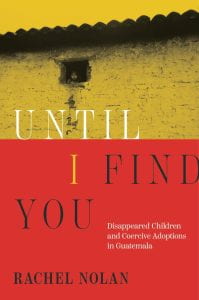A Review of Until I Find You: Disappeared Children and Coercive Adoptions in Guatemala
A student in my “Introduction to Cultural Anthropology” course at the University of Delaware approached me several weeks ago, after hearing about my long-term research in Guatemalan communities, to tell me that they were born there, in Guatemala. They’ve “never been,” but they hope to visit someday. The student does not know the name of their town of origin or the story of their birth parents, but they have a vague sense that they were left on church steps or at an orphanage door by a mother who could not take care of them. The student is loved dearly by their parents in the United States, and they have had every opportunity to live a healthy and successful life.
No matter the happy endings experienced by so many people who were born abroad and then adopted into stable, resourced and loving homes, Rachel Nolan’s Until I Find You insists that the truth about international adoption is deeply disturbing, even horrifying. “Many people in wealthy countries had long seen international adoptions as selfless acts of charity,” writes Nolan. But she convincingly argues that Guatemala’s international adoption program—and parallel programs in some other countries—functioned as a “commercial market” for selling children. Nolan’s research further reveals that international adoptions were a powerful tool of political violence used to terrorize the country’s indigenous Maya majority during the 36-year war (1960-1996) carried out by the Guatemalan state against its own people. One of the book’s major contributions to Latin American history, in fact, is to situate the orphaning, forced disappearance and coercive adoptions of Indigenous children within the broader picture of genocidal violence in Guatemala.
Until I Find You: Disappeared Children and Coercive Adoptions in Guatemala by Rachel Nolan (Harvard University Press, 2024, 309 pages)
Until I Find You presents a painstakingly researched history of international adoptions from Guatemala. Nolan collected information through interviews with attorneys, social workers and adoptees and through impressive archival research, including in the now inaccessible files kept by the social workers who facilitated adoptions. The book provides a thorough account of the process through which Guatemala became the second-highest “sender” of children to adoptive families abroad by the early 2000s. Between 1977 and 2007, a country of only 14 million people sent nearly 30,000 children to new homes, mostly in the United States, Canada and Western Europe, through a private, for-profit . “We exported babies,” as one Guatemalan attorney commented to the press. The adoption market enriched the country’s political and economic elite and preyed upon structurally-marginalized, sometimes terrorized, Indigenous communities.
Nolan brilliantly contextualizes Guatemala’s international adoption program within the country’s broader political and economic history. We learn, for example, about how the massive earthquake that devastated the capital region and central highlands in 1976 opened the door for Guatemalan attorneys to privatize adoption as an “efficient” solution to housing children who lost one or more parents to the disaster. No matter that many children had surviving relatives or neighbors willing to care for them. No matter that the government’s emergency response efforts unevenly benefited already resourced communities and left Indigenous-majority towns without formal assistance. And no matter that the international response to the disaster ignored the context of military and political violence, which would only escalate in the ensuing years. Nolan recounts how international adoption provided an avenue for the government to “disappear” children orphaned by the large-scale massacres of Indigenous communities carried out by the military in the early 1980s. Her extensive research and documentation of these crimes is vital to ongoing efforts in Guatemala to bring to justice those responsible for wartime atrocities.
The book connects international adoption to other important themes and events in Latin American history. Across the chapters, we learn a great deal about the history of domestic labor in Guatemala, changing conceptions of childhood and children’s rights in the 20th century, and how Protestant Christian mission work helped to propel the international adoption market. Nolan attunes readers to the ways that limitations on women’s reproductive rights in Guatemala and racist ideas about “unfit” Indigenous mothers spurred the adoption market, too. The famed jaladoras— women who were paid by attorneys to deliver infants for export—found success in a context where restrictions on healthcare access, war, racism, misogyny and the utter lack of social services colluded against Maya women and rendered Indigenous children available for commodification.
International adoption from Guatemala was banned in 2008. And international adoption has lost popularity worldwide as journalists, human rights groups and academic researchers have drawn greater attention to widespread problems. Nolan insists, however, that the criminal and predatory nature of Guatemala’s adoption program was well-known from the beginning. She pushes readers to ask why it took so long for action to be taken when rumors had circulated for decades. And not just rumors. Members of the Guatemalan Congress and officials in the US Embassy knew as early as the mid-1980s that the system involved corruption, kidnapping and murder, yet they did nothing to stop it, she writes. In 2000, the Catholic Church published a report focused on the forced disappearances of children during the war and the efforts of family members to find them. (Nolan takes the title of her book from this report, though we learn frustratingly little about its contents). Until I Find You is the first comprehensive account of the violence associated with adoption in Guatemala, but Nolan makes it clear that the leaders of prominent institutions have long known the truth. Time and again, they chose to ignore it.
Nolan laments that only one Guatemalan attorney has gone to prison for adoption-related crimes, though several jaladoras (who earned far less pay and were sometimes impoverished and Indigenous themselves) have been tried and convicted. Nolan also emphasizes that the conditions of marginalization affecting Maya communities did not end with the adoption ban. Neither did international demand for reproductive services, as illustrated by the growing popularity of international surrogacy, which often entails relations of deep inequality between surrogates and intended parents. Until I Find You is a well-written, highly accessible and powerful indictment of the Guatemalan adoption program, the state regimes that utilized it as a tactic of war, the attorneys who profited from it, and the neocolonial relations of power and inequality that allowed the system to thrive. It is also a cautionary tale about naivety and complicity in globalized systems of exploitation and control—the “lies we love,” as Nolan phrases it.
Kedron Thomas is Associate Professor of Anthropology at the University of Delaware. She is the author of Regulating Style: Intellectual Property and the Business of Fashion in Guatemala and co-editor of Securing the City: Space, Insecurity, and Neoliberalism in Postwar Guatemala.
More Student Views
Colombian Women Who Empower Dreams
English + Español
The verraquera of Colombian women knows no bounds. This was the message left with me by the March 30 symposium, “Empowering Dreams: 1st symposium in honor to Colombian women at Harvard.”
A Review of Born in Blood and Fire
The fourth edition of Born in Blood and Fire is a concise yet comprehensive account of the intriguing history of Latin America and will be followed this year by a fifth edition.
Resilience of the Human Spirit: Seizing Every Moment
In the heart of Chicago, where I grew up, amidst the towering shadows of adversity, the lingering shadows of generational demons and the aroma of temptation, the key to the gateway of resilience and determination was inherited. The streets of my childhood neighborhood became, for many, prisons of poverty, plundering, crime and poor opportunity.




